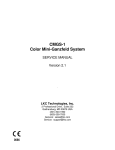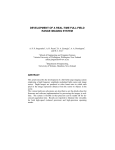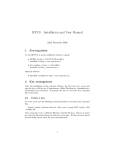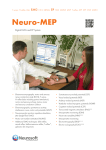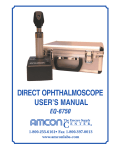Download Clinic 6.0.9 - Electro-Diagnostic Imaging, Inc.
Transcript
Clinic 6.0.9 [email protected] http://www.veris-edi.com Visual Evoked Response Imaging System Short User Manual Electro-Diagnostic Imaging, Inc. 200F Twin Dolphin Drive Redwood City, CA 94065-1402 Manual-CLIS-C VERIS™ 6.0 Clinic Guide 2 Table of Contents _____________________________________________________ Chapter 1 Chapter 2 Getting Started with VERIS™ 6.0.9 3 Setting your VERIS Preferences 3 Basic Operation of VERIS 6.0.9 6 Identifying the Patient (Subject) 6 Specifying a Test 6 Recording and Saving the Data 7 Analyzing Patient Data 10 Locating Patient Data Folders 10 Loading Data Files for Analysis 10 Viewing the Displayed Data 11 Averaging Test Data Replicated on the Same Day 12 Adding (Concatenating) Test/Analysis Protocols 12 Modifying Analysis Settings 12 Adjusting Vertical Scaling 12 Changing a Plot's Digital Filter Settings 13 Correction of Operator Errors 13 Editing Patient Information or eye tested 13 Inverting Polarity of Recorded Data 15 Chapter 3 Specifying and Using Baseline Files 16 Chapter 4 Creating and Using "Normals" Files 17 Creating a New "Normals" File Sorting "Normals" by Age Comparing Recorded Data to Normals 17 18 18 Calibration Instructions for VERIS™ 6.0.7 and Later 19 Appendix 1 Manual-CLIS-C VERIS™ 6.0 Clinic Guide 3 1 - Getting Started With VERIS™ 6.0 _____________________________________________________ Welcome to VERIS™ 6.0.9. This newly enhanced version simplifies program use for the technician while maintaining the versatility and flexibility of previous versions. With this new version all electrophysiological tests have been integrated with improved data handling and control. All patient (or subject) data is automatically placed in that patient's folder with privacy protection features. Comparison of multiple re-tests is now easily accomplished. Recording and analysis protocols provided by EDI now have revision controls. All VERIS™ systems include pre-programmed Recording and Analysis protocols. In VERIS™ Science you can also design your own Recording and Analysis protocols. The first step in working with VERIS 6 is to customize your application preferences, defining the default storage location for your VERIS data, the information to be entered and saved for each new patient, the type of calibrator used with your system, and other environmental and security parameters. Customizing Your VERIS™ Application Preferences 1. Click on the VERIS icon, located in the "dock" at the bottom of your screen, to start the program. 2. From the VERIS pull-down menu, select "Preferences." 3. VERIS will ask you for the administrator Password. Enter the Password. Manual-CLIS-C VERIS™ 6.0 Clinic Guide 4 4. The "Application Preferences" window will open. W A R N I N G ! Choosing your preferences must be done with great care. Subject Titles in particular will be used for finding and sorting files by subject fields. If you change Titles we strongly encourage consistency. By default, the program creates a title for each recorded data file using the entire field (Last Name) and first letter of the field (First Name). EDI suggest that for the present you proceed with the default settings but choose your own preferences in the very near future after you have acquired some experience with the software. Adding/Removing and Creating Patient Information Fields Under Subject Titles are three columns containing titles for subject information. The left column contains the titles that you want VERIS to use in your application. The center column contains additional VERIS titles you can add to your application. The right column contains your own Custom titles. • To add titles to the VERIS application select them from the center or right column and drag them into the left hand column. • To remove titles, simply drag them back to their column of origin. • To create a Custom title, click the "Add Title" button, enter a name and select the data type to be associated with this custom title. Manual-CLIS-C VERIS™ 6.0 Clinic Guide 5 Specifying "Required" Information Fields Titles in the left column having a check mark are "required" information that must be filled for a new patient prior to continuing. • To define required titles place a check mark by clicking to the left of any titles you may have placed in the left column. Assigning the Default Data Folder Location By default, all data are saved in the "Veris Data" folder located within the Users / Documents folder. Data can be stored on any storage device or remote server. • To assign a different location for your Data folder, click the “Select new location” button located at the top of the Preferences window. Defining "Subject" Preference You can select what the subjects of your recordings will be called, i.e. Patient (as in a clinic environment) or Subject (as more appropriate in a research laboratory). • To define your preferred terminology for subject, type in the text you wish to substitute under "Terminology defaults" at the bottom of the “Preferences” window. File Locking and Authorization for Data Security You can lock your data files so they can be viewed within the VERIS application but cannot be changed in any way without supplying the Administrator password. You can also require password authorization in order to modify the program preferences. • To "Keep files locked" or "Require Authorization", check the appropriate box at the bottom of the "Preferences" window Specifying Calibrator Type • Place a check in the "Using Spot Calibrator" checkbox if using the new spot calibrator. Leave the checkbox empty only if using the older auto-calibrator. Specifying Power Line Frequency • Select either 60 or 50 Hz from the Power Filter cycles drop-down menu to identify the line frequency of AC power at your location. This automatically sets the digital notch filter frequency in the Edit Filters window for all data analyses. Manual-CLIS-C VERIS™ 6.0 Clinic Guide 6 2 - Basic Operation of VERIS™ 6.0.9 _____________________________________________________ The fundamental steps for performing any test are as follows: 1. Identifying the patient by creating the patient's folder (or opening a previously tested patient's folder). 1. Specifying a test 1. Recording and saving the data. 1. Identifying the patient Creating a data folder for a new patient After entering the patient's ID number, you will be prompted to "Fill in required fields." All fields with asterisks must be filled in. Then you will be prompted to "Create new folder" for this patient's data. Click on "Create new folder" and the new folder will be opened with an empty field displayed in the File Viewer panel to the right. Opening the data folder for a previously tested patient If you know the patient's ID number, enter it into the ID# field and press the keyboard "return" key. The patient's subject information will appear and the File Viewer panel to the right will list the data files recorded from that patient. If you do not know the patient's ID number, you can enter a portion or all of the patient's first or last name in the appropriate field, and VERIS will identify matching records in a drop-down menu. Click on the drop-down menu to select and open the appropriate patient's folder. 2. Specifying a test There is a set of Test/Analysis Files provided for every EDI stimulator. Each Test/Analysis file consisting of plots with associated analysis parameters for one or more electrophysiological tests. 1) Click "Select" on the VERIS menu bar and choose "Select Test/Analysis." A new file navigator window opens, providing access to all test/analysis protocols on your system. 2) Select a test/analysis file that you have used before from the Recently used files drop-down menu or click the small triangle next to the folder corresponding to the stimulator hardware you are using to show the test/analysis protocols available for that stimulator. 3) From these protocols select an analysis file for the specific test you want to run, then click "OK". Manual-CLIS-C VERIS™ 6.0 Clinic Guide 7 Upon opening the analysis file, a series of colored tabs will appear to the right of the Patient (Subject) tab in the VERIS window. Each tab contains one or more plots. These plots may reflect the same test or different tests. If there are no previous records from this patient, all plots will be empty. If test data from the patient exist, the plots for these tests are automatically filled showing you the most recent data. 4) Click on any tab that contains plots for the test you want to run. In some cases (e.g., fullfield ERG protocols) each tab in a file represents a different test, while in others (e.g., multifocal ERG protocols) each tab provides a different representation of data from the same test. 5) For some tests, there are separate plots for each (i.e. right or left) eye. If this is so, click in the plot area of a plot for the eye and test you require. A small red recording button will appear above under the tabs and the eye that was selected will be shown. Binocular Recording Some tests (e.g., full-field ERGs) can be recorded binocularly. To record binocularly, after selecting a plot for the specific test you want to run, click on the recording button while holding down the keyboard <option> key. You will be instructed to connect the electrodes for the right eye to Channel 1 and from the left eye to Channel 2. Then proceed normally to the recording window. 3. Recording and saving the data 1) Click the red button and wait. A window will appear that allows you to enter optional additional information and comments for the eye(s) being recorded. Click "Yes" to continue. 2) If VERIS detects that a remote controlled amplifier is connected, the amplification and filter settings are automatically loaded from the recording settings file when entering recording. If a remote controlled amplifier is not found, VERIS reminds you when entering recording to manually check that the amplifier settings are correct. A small, spinning colored wheel will appear while the recording environment is established and a data file is created, then the recording window will appear. Above figure shows recording window for full-field ERG. Subject shown undilated, without electrodes. Manual-CLIS-C VERIS™ 6.0 Clinic Guide 8 3 ) Prepare and position the patient for recording. 4) Clicking anywhere within the video image window or on the "Calibrate Camera" button opens a window with brightness, contrast, and other settings for the eye camera and (FMS only) fundus camera. 5) The "Edit Amplifier" button provides access to the current amplifier settings and electrode impedance measurement. 6) For full-field flash tests, the Auto-Repeat function can be turned on or off by adding or mfERG Recording Window (Undilated, No Electrode) removing a checkmark in the "Auto-Repeat" checkbox. a) Click the Flash button to present a single flash or to initiate the pre-defined auto-repeat sequence of flash stimuli. For multifocal ERG or most other tests, click on the “Record Next Segment” button to begin recording. A "Segment Progress" bar below the buttons shows the progress in the recording of the segment. Repeat step # 3 until all segments have been recorded. The Record Next Segment button now becomes Accept Recording. 7) After the recording has been accepted, the data automatically appear in the plot and all other plots that correspond to this test. 8) If previously recorded data for the test had been represented in the plot, they are now replaced by the results from the new test. 9) For tabs containing plots with one or multiple retests, you may enable the recording of the test by clicking on any one of the plots. When the new record is accepted, its data appear in the plot for the most recent record and all previous records are again shown in timesequential order. 10) A Test Number uniquely identifies the recording settings for each of the available stimulators. When a plot Manual-CLIS-C VERIS™ 6.0 Clinic Guide 9 is selected and you click on the Show Info button next to the Record button, the plotting parameters and the Test Number for the record in the plot appear in the left boarder of the window. Double clicking on the code brings up the settings of all the corresponding recording parameters. Manual-CLIS-C VERIS™ 6.0 Clinic Guide 10 Analyzing Patient Data 1. Locating patient data folders Locate a patient folder any of the following ways: 1) If you know the patient's ID#, simply enter it into the ID # field of the Subject Page and press the "tab" or ""return" key on your keyboard. 1) If you do not know the patient's ID# but do know the patient's first or last name, begin typing it in the appropriate Name field of the Subject Page. A "Choices" drop-down menu will appear containing all records that match what you have typed. Just click on the correct entry in that list to open the patient's folder. 1) You also can simply find the folder in the File Viewer panel at the right. Just double-click on the folder icon to open the folder and load the subject information. This works best if you have only a small number of patient folders in the File Viewer. 1. Loading data files for analysis Open the patient's data folder using any of the methods above. (You can widen the File Viewer panel so that the entire file names are visible by click/dragging it's inner boundary to the left.) To view the most recently recorded data from the patient whose folder is open, 1) Click on Select > Select Test/Analysis... on the VERIS menu bar to open a Finder window. 1) Click on the "Recently used files" bar. 1) Select an analysis settings file appropriate for the test data you want to view and click "OK". The analysis file will open and the most recently recorded data for that test will be displayed automatically. To view any data file, 1) Click on the data file's icon while holding down the keyboard <control> key. A context menu will appear with two choices. Either, 1) "Open the File..." (replacing any analysis tabs already open in your window), or, "Add the File..." (appending the new file's analysis tabs to any that already are available in your window). When you choose either of these options, a list of all analysis files on your computer that are appropriate to the chosen data file will be listed. The most recently used ("preferred") analysis settings for the chosen data file will be marked with a dark diamond symbol. Just click on the analysis file you want to use to load it with the selected data file. or, 1) Double-click on the desired file's icon to open the file with its "preferred" analysis settings (if a preferred analysis file is assigned). WARNING: When you open a file by double-clicking on its icon in the File Viewer, the sequence number of the plots displaying its data changes to that of the file being viewed. If you save the analysis file, these plots will be saved with the changed sequence numbers. [Important Note]: Double-clicking on a folder or data file icon while holding the keyboard <option> key down will open it in a new window with the same analysis file that is currently open. Manual-CLIS-C VERIS™ 6.0 Clinic Guide 11 1. Viewing the displayed data After opening a data file with an appropriate analysis settings file, a number of tabbed pages are added to the Subject tab, each of the new tabs displaying one or more plots. Each plot in every tab is prepared for a specific test that is identified by the plot's "test number". Plots for the same or different tests can be displayed on the same page. When a plot is empty, it is labeled with the test number, sequence number and channel number (in the case of multi-channel recording) for the data that fit into the plot. All of the patient's data files are listed in the File Viewer on the right side of the window and are color coded. • All data files whose data is plotted in the current tab are shown in bold green. • Additional data that would fit into a selected plot are shown in bold black. • Data files that are not plotted in the current tab are listed in grey. You may drag any one of the bold black colored data file names into the blue file name displayed in a selected plot. Two processes happen automatically: • The data of the plot into which the file is dropped are replaced by the data of the new file. • The files in all the plots of that tab for the corresponding test are rearranged in time sequential order. When there have been multiple replications of the same test for a single patient, the data files are assigned sequence numbers according to their recording dates starting with "1" for the most recent date of recording, "2" for the next most recent date, etc. If only one eye is tested on a particular date, only that eye's data file receives that date's sequence number. When two or more files are recorded applying the same test to the same eye on the same date, only the last file recorded that day from each eye is assigned that date's sequence number. In tabs containing plots for multiple replications of the same test, the data are automatically presented in according to the sequence numbers assigned to the plots. Plots for tests (or eyes) not previously recorded on a particular testing date are empty and labeled with the test number for the type of test data that fits into the plot. Manual-CLIS-C VERIS™ 6.0 Clinic Guide 12 1. Averaging data replicated on the same day If you repeat a test of the same eye on the same day, a new data file containing the average of two or more of the individual recordings can be created. Select a plot appropriate for the files to be averaged. Then simply select the files to be combined by clicking on them in the VERIS File Viewer while depressing the <command (apple)> key of the keyboard. Finally, drag the selected files together into the file name displayed in the selected plot. A new data file will be created with the word "Average" in it and the plot will be updated to display the averaged data. Note that all files to be averaged this way must be for the same eye and test number and have the same recording date. 1. Adding (concatenating) analysis protocols A window with all its tabs and plots constitutes a test/analysis protocol. In this protocol you may assemble all the tests and corresponding plots normally performed and save the file with the new test sequence for future use (with VERIS Science or Pro). If you are viewing one test/analysis protocol and feel that another one should be added, use the Add Test/Analysis command from the Select drop-down menu. The tabs of the added test/analysis protocol are then automatically appended to the string of tabs in the window. To save this combined view as a new test/analysis protocol, use the Save As..., Save Test/Analysis As... command from the File drop-down menu. Similarly, you can replace one protocol with another using the Replace Test/Analysis command, or delete a protocol's tabs with the Remove Test/Analysis command. Modifying Analysis Settings VERIS Clinic allows a restricted set of modifications to analysis settings that are necessary for clinical use. These include changes to vertical scaling of data plots, artifact rejection, spatial averaging and digital filtering of recorded data, and the correction of certain recording errors such as waveform inversion due to the incorrect electrode connections to the amplifier. For complete control over the recording, analysis, and display of electrophysiological data, contact EDI to upgrade to VERIS Science or VERIS Pro. 1. Adjusting Vertical Scaling of a Plot 1) Select a plot. 1) Click on the "Vertical Scaling" button at the upper left. 1) A dialog window will open the allows you to change the vertical scaling value. 1) Enter a new vertical scaling value and click "OK". Manual-CLIS-C VERIS™ 6.0 Clinic Guide 13 1. Changing a Plot's Digital Filter Settings During Data Processing 1) Select a plot. 1) The data in each plot can be filtered separately and in different ways. Additionally, each overlay source can be uniquely filtered. a) Select the button labeled "Edit Filters..." to open the parameter settings for that plot. a) Select the Overlay Source(s) you want to filter and click OK. (Usually one wants to "Filter all overlays the same", but VERIS also allows independent digital filtering of overlays.) a ) Edit the filtering as needed and click OK to implement it. Note that you must first check the filters you wish to add, in order to modify their individual control values. These are the same filters available in VERIS 5. They are described in detail in your VERIS 5 Reference Guide. Since, in VERIS 6, digital filtering is applied per plot, it is possible to present the same data set filtered in different ways in separate plots in the same window or tab. Correcting Operator Errors 1. Correcting Errors in Patient Information or Eye Tested 1) Select a plot containing the data for a file to be edited. 1) Double-click on the blue colored file name at the top of the plot. If you checked Require Authorization in your VERIS Preferences, a dialog box will appear with the message: "Do you want to edit the file “……..” ? This will require authorization." If you answer Yes and then supply the Administrator Password, you will access a window for editing the patient information and the recording parameters stored in the record. Manual-CLIS-C VERIS™ 6.0 Clinic Guide 14 A Data File Editing Window 1. To correct patient information that was incorrectly entered, just edit the items as needed in this window and click "OK". Before saving the file, you also should correct any errors in the file name. If you save the data with a new file name, do not forget to delete the incorrect file. 1. To correct the eye tested (e.g., if the right eye was selected for recording but you accidentally recorded from the left eye instead), click on the icon labeled "Misc" at the upper left. A window like the one pictured below will open. Select the correct eye from the drop-down eye menu then click "OK" at the lower right corner of this window and again in the "Edit Data File" window. When prompted to save the file, correct the eye designation in the file name before saving it. Then remember to delete the incorrect file from the VERIS file viewer by dragging it to the trash. Manual-CLIS-C VERIS™ 6.0 Clinic Guide 15 1. Inverting Polarity of Recorded Data 1) Highlight the data file to be corrected by clicking on its icon or file name in the VERIS File Viewer panel at the right. 1) Select the data file you wish to change and click OK. Polarity of the selected file will be inverted. Manual-CLIS-C VERIS™ 6.0 Clinic Guide 16 3 - Specifying and Using Baseline Files _____________________________________________________ Overview Sometimes it is useful to compare the results of all subsequent tests from an individual subject to the same, single (baseline) recording. In VERIS 6.0.8 and later, you may select any file from the File Viewer at the right of an analysis window and designate it a baseline file. All other records of the same type (and eye) can easily be compared to the baseline recording. In addition to its normally assigned sequence number, a baseline file always has a sequence number of "0" (zero). Specifying a Baseline File 1) Open the folder of a patient previously tested. 1) Select the file you wish to designate as a baseline file in the File Viewer at the right by clicking on its file name. 1) From the VERIS menu bar, select Select > Select File as Baseline. 1) A "B" will be appended to the file name to designate its status as a baseline file and it will be assigned a sequence number of zero in addition to its normally assigned sequence number. Removing a Baseline Designation from a Data File Select a file that is already designated as a Baseline file and perform the baseline file specification procedure above. You will receive a prompt stating that the file already is a Baseline file and asking whether or not you want to remove that designation. If you select "Yes", the "B" will be removed from the file name and the file will no longer be a Baseline file. Changing the Baseline File If you select a file to designate as a Baseline file, but there already is a baseline file specified for that test type and eye, you will receive a prompt listing the current Baseline file and the new one that you have just specified and will be asked if you want to change the Baseline designation to the new file. If you select "Yes", the "B" will be moved from the previous Baseline file to the newly specified one. Comparing Baseline Files to Other Data Files For however long a file is designated as a Baseline file, it is assigned a sequence number of "0" in addition to its normally assigned sequence number. To specify the baseline file as a plot source, you need only select 0 for the plot number. Thus, display a baseline file in any plot, either by itself or as an overlay in the same plot as another data file of the same type from the same eye. You also can perform simple arithmetic operations between the Baseline file and any other plot source. Manual-CLIS-C VERIS™ 6.0 Clinic Guide 17 4 - Creating and Using "Normals" Files _____________________________________________________ A VERIS "normals" file is a "combination file" comprised of averaged data recorded from any number of normal subjects. The result can be plotted together with results from a single subject or one can plot the differences of the subjects data and the normal data in units of standard deviations from the normal means. The data also can be arranged automatically into pre-defined age groups. If this option is employed, then newly recorded data will be compared automatically to the correct age group of normal subjects. It is most convenient, but not essential, to group your normal subjects' folders within a separate folder in your default VERIS data folder using the OS X Finder. 1. Creating a New "Normals" File 1) From the VERIS menu bar, select File > New Combination. 1) Enter the system password, if prompted. Enter a file name for your new normals file and save it in the Normals folder in your VERIS application directory. A combination file window will open with a file viewer pane at the right and four different panels to the left. 1) Select one or more normal data folders from the File Viewer and drag them into the Folders panel at the upper left. Wait while the data files from those folders are sorted and averages are calculated. You may then continue to add more normal data folders until all have been entered into the Folders area. 1) Now, you may either close the window or, if you have a sufficient number of normal data files, you can select appropriate age ranges for additional sorting by age. Manual-CLIS-C VERIS™ 6.0 Clinic Guide 18 1. Sorting "Normals" by Age Often it is appropriate to compare clinical data to recordings obtained from normal subjects of similar age. VERIS 6 will do this automatically if you select appropriate age ranges in your "Normals" combination file. 1) From the VERIS menu bar, select File > Open. Select "Show only Combination Files", then navigate to the "Normals" folder in your VERIS application directory and open the file you wish to change. 1) Click on the "Edit Ages" button. 1) Enter age ranges, taking care to ensure that you select ranges which each contain a sufficient number of subjects from whom to calculate meaningful averages and standard deviation values. Selected age ranges must not overlap or an error message will result. 1) Close the "Edit Ages" box by clicking on the OK button. 1) Your data files will be re-sorted and new calculations will be made according to the age ranges you have selected. 1) When the calculations are complete, you may close the Combinations File editing window and the file will be saved. 1. Comparing Recorded Data to "Normals" EDI provides analysis settings files that compare most recordings to a "Normals" file that the user selects. With VERIS Science or Pro, you can customize these files or create new ones to your own specifications. 1) Open a recording file. 1) Open an Analysis Settings file appropriate for that recording that refers to "normals" in its file name (e.g., "mfERG 103h 7m 200cd with normals.m21"). 1) From the VERIS menu bar, choose Select > Select Normals File... 1) Choose the Normals file you want to compare to from the list of files in the "Normals" folder of your VERIS application directory. Then select any tab. VERIS will automatically apply any artifact rejection, spatial averaging, and filtering specified for the plots in that tab and will display the recorded data with comparison to the chosen normal data. 1) IMPORTANT: Plots that compare subject data to averages of normal data in units of standard deviation from the mean are re-calculated whenever there is a change to filter settings or other parameters such as artifact rejection or spatial filtering. If you save the new parameter settings for future use, you also should select the standard deviation plot and save the new calculations in the current "Normals" combination file by selecting from the VERIS menu bar: File > Save STD data. By doing this, you can avoid having to re-calculate the means and standard deviations of the normal data every time you view a new recording. Manual-CLIS-C VERIS™ 6.0 Clinic Guide 19 Appendix 1 Calibration Instructions for VERIS™ version 6.0.7 and Later Spot Calibrator in Eye Camera Calibrator Adapter Removing Spot Calibrator (ECCA) General Setup and Overview The Spot Calibrator and Eye Camera Calibrator Adapter (ECCA) are used together with the version 6 VERIS™ software for calibration of all EDI CRT or FMS stimulators. To calibrate the Ganzfeld 2 full-field stimulator, the Spot calibrator is removed from the Eye Camera Calibrator Adaptor by loosening the set screw on the side of the Eye Camera Calibrator Adapter . The other end of the Spot Calibrator cable plugs into the middle DB25 connector labeled "Auto Calibrator" on the switchbox at the back of the computer. VERIS 6.0.7 and later identifies the device being calibrated through the recording settings associated with the test selected by the user. Earlier versions of VERIS 6.0 require the user to select the device to be calibrated from the Calibration drop-down menu. Preparing for Calibration 1. Turn on the stimulator that you want to calibrate. For pattern stimulators like CRT, FMS, or EMS devices) run "Detect Displays" from the OS X Displays menu. Verify that the correct display setting is chosen (e.g., 1280 x 1024 75 Hz for FMS/EMS stimulators) and the display is operating normally. 1. Open VERIS (6.0.7 or later). 1. Select VERIS Preferences from the VERIS drop-down menu at the upper left and enter your password to view the VERIS Preferences window. 1. Verify that the "Spot Calibrator" checkbox is checked if you are using a Spot Calibrator or that it is unchecked if you are using the older Auto Calibrator. Then close the preference window. If you changed the setting, you should now close and restart the VERIS application. 1 . From the "Select" drop-down menu, click on "Replace Test/Analysis..." and choose a Test/Analysis file that uses the stimulator you want to calibrate. 1. Click on (select) any plot that uses the device you want to calibrate. Manual-CLIS-C VERIS™ 6.0 Clinic Guide 20 Measuring the Calibrator Dark Current 1 . Select "Calibration" from the VERIS menu bar and "Calibrator Calibration" from the sub-menu. 2. Block the opening to the Spot Calibrator so no light reaches the detector, then click the "Read" button to measure the detector's dark current. The button label will change to "Stop". When the reading stabilizes, press the ("Stop") button to stop reading. Then click the "OK" button to save the reading. The reading should be between 300 and 400 for spot calibrators. If it is outside this range, contact EDI Support. 3. Click on OK at the bottom left of the window to save the dark current calibration. Calibrating Your Stimulators • • • • • Mount the calibrator on your stimulator as follows: a. Rotate the Ganzfeld so that it is face-up. Center the calibration card on the opening of the Ganzfeld and insert the Spot Calibrator into the hole in the center of the calibration card. b. Securely mount the Spot Calibrator with ECCA hood attached to the front of your FMS, EMS, or Refractor/Eye Camera lens as shown. If you are using a 21-inch CRT display without a Refractor/Eye Camera, suspend the calibrator, centered front of the display with its lens 40 cm. from the CRT using the provided suspension rod. c. If you are calibrating a VERIS 2000 Ganzfeld, the calibrator is internal. No Spot Calibrator or Auto Calibrator is needed. From the Calibration drop-down menu, select Auto Calibration. VERIS will automatically provide the correct calibration procedure for the device used for the selected plot in the Test/Analysis window. Turn off the room lights, then click on the "Start" button in the calibration window. Wait for the calibration to complete. All of the calibration curves should be continuous, looking much like the examples shown. Click the "OK" button at the lower right of the calibration window to save the results. Then restart VERIS to use the saved calibrations. Manual-CLIS-C VERIS™ 6.0 Clinic Guide

























